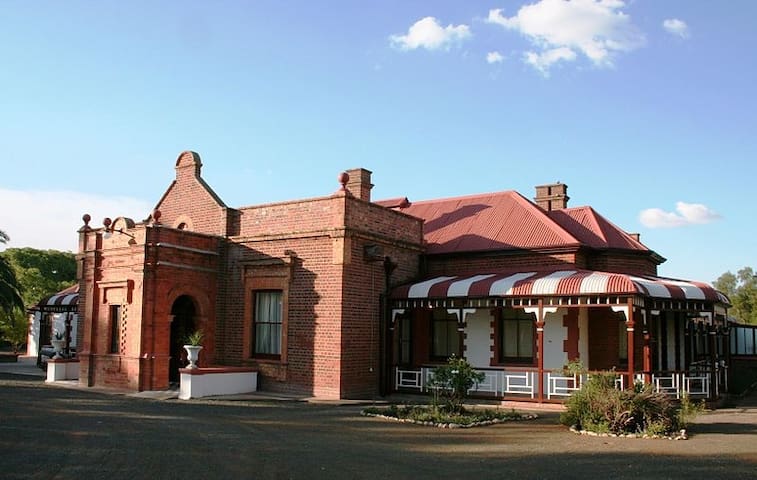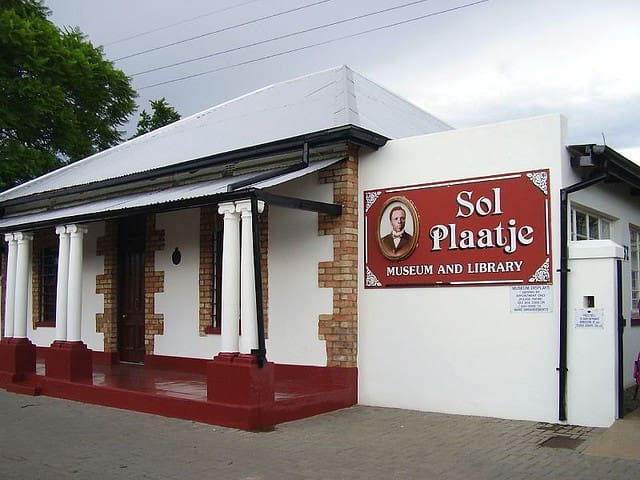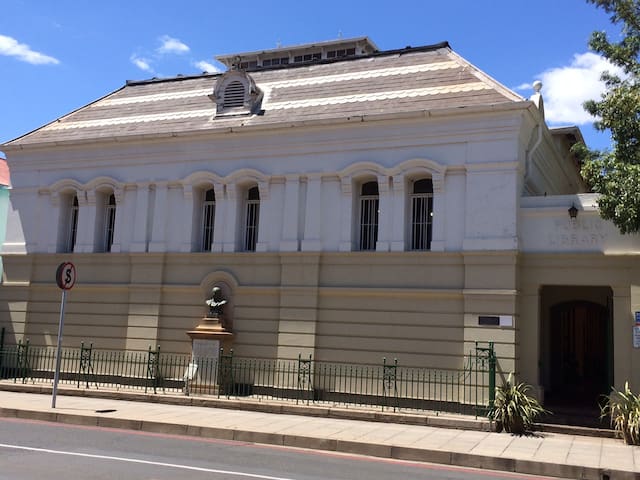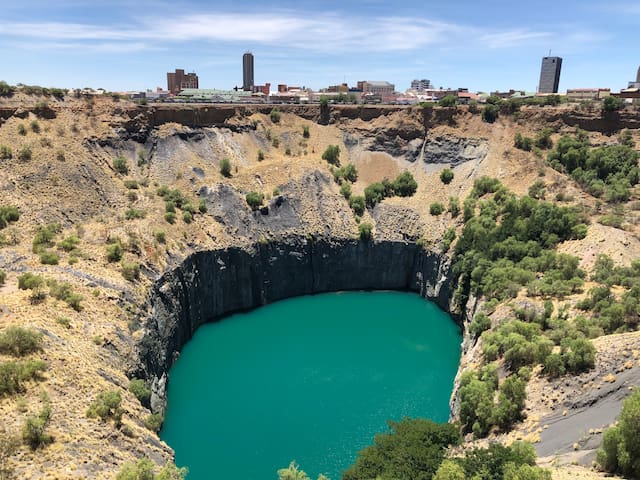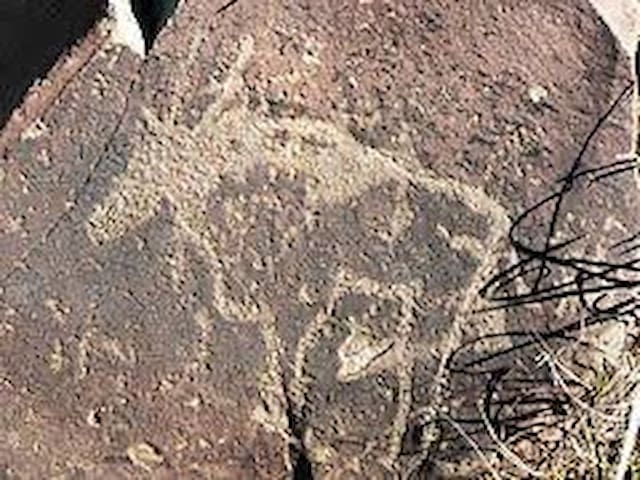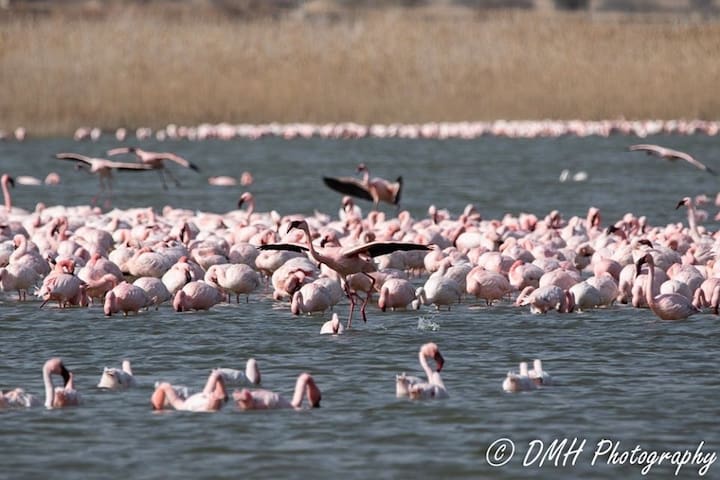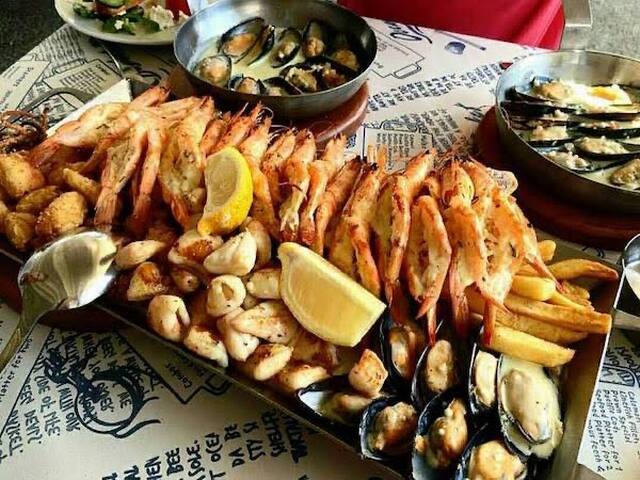Arts & Culture
Duggan Cronin Gallery next to the McGregor Museum
Duggan-Cronin arrived in Kimberley in 1897. He worked in the De Beers compounds, where he began to build up a photographic record of the different tribes working on the mines. Encouraged by Maria Wilman, he undertook expeditions to the main tribal areas, where he photographed the people before the Western influence drastically changed their traditional ways of life. T
The Duggan-Cronin collection consists of negatives and prints, as well as artefacts of material culture of the tribes, including beadwork, costumes, pottery, iron tools and wood carvings. A selection of his photographs have been included in publications such as The Bushmen Tribes of Southern Africa and The Bantu Tribes of South Africa.
Today the McGregor Museum is responsible for the maintenance of this collection. which is housed in a building in Belgravia originally known as The Lodge, but today simply known as the Duggan-Cronin Gallery.
7 paikallista suosittelee
Duggan Cronin Gallery
17 Egerton RdDuggan Cronin Gallery next to the McGregor Museum
Duggan-Cronin arrived in Kimberley in 1897. He worked in the De Beers compounds, where he began to build up a photographic record of the different tribes working on the mines. Encouraged by Maria Wilman, he undertook expeditions to the main tribal areas, where he photographed the people before the Western influence drastically changed their traditional ways of life. T
The Duggan-Cronin collection consists of negatives and prints, as well as artefacts of material culture of the tribes, including beadwork, costumes, pottery, iron tools and wood carvings. A selection of his photographs have been included in publications such as The Bushmen Tribes of Southern Africa and The Bantu Tribes of South Africa.
Today the McGregor Museum is responsible for the maintenance of this collection. which is housed in a building in Belgravia originally known as The Lodge, but today simply known as the Duggan-Cronin Gallery.
Not only was the McGregor Museum one of the earliest museums in South Africa, it is still considered to be one of the finest. In 1973 the museum staff and collections moved from the building in Chapel Street to these new premises on Atlas Street in Belgravia, the building that has in the past served as a sanatorium, a hotel and a convent. The McGregor museum is the custodian of a number of other facilities in Kimberley and further afield.
An exhibition on the Liberation Struggle as it touched on the lives of the people in the Northern Cape, is relevant and enlightening. Other exhibitions which are popular attractions and a constant source of reference to schools, local and foreign visitors include the Ancestors Gallery, the Enviro Zone, the Convent School Display, the Siege Gallery and the Hall of Religions .
The museum houses major natural history and cultural history collections including a botanical herbarium, zoology collections, a history archive, ethnography collections, archaeology and rock art collections, physical anthropology, palaeontology and geology collections.
Most of these fields are represented by professional staff and collection managers, and the collections and associated research programmes are reflected in permanent and temporary exhibits in various sections of the museum as well as in outreach programmes in the province and displays in smaller museums.
Address: Atlas Street, Kimberley, 8301 Phone: +27 538311761
14 paikallista suosittelee
McGregor Museum
Atlas StreetNot only was the McGregor Museum one of the earliest museums in South Africa, it is still considered to be one of the finest. In 1973 the museum staff and collections moved from the building in Chapel Street to these new premises on Atlas Street in Belgravia, the building that has in the past served as a sanatorium, a hotel and a convent. The McGregor museum is the custodian of a number of other facilities in Kimberley and further afield.
An exhibition on the Liberation Struggle as it touched on the lives of the people in the Northern Cape, is relevant and enlightening. Other exhibitions which are popular attractions and a constant source of reference to schools, local and foreign visitors include the Ancestors Gallery, the Enviro Zone, the Convent School Display, the Siege Gallery and the Hall of Religions .
The museum houses major natural history and cultural history collections including a botanical herbarium, zoology collections, a history archive, ethnography collections, archaeology and rock art collections, physical anthropology, palaeontology and geology collections.
Most of these fields are represented by professional staff and collection managers, and the collections and associated research programmes are reflected in permanent and temporary exhibits in various sections of the museum as well as in outreach programmes in the province and displays in smaller museums.
Address: Atlas Street, Kimberley, 8301 Phone: +27 538311761
WHAG, as it is affectionately known by Kimberlites, is considered one of the finest art museums in South Africa. In 1948 William Humphreys (1889 - 1965) donated to the city a substantial portion of his personal collection of 16th and 17th Century Dutch and Flemish Old Masters, British and French paintings, antique furniture and other objects d'art. The gallery, named after its principal benefactor, opened in 1952.
This gift combined with the South African works of art brought together by members of the Art Section of the Kimberley Athenaeum and The Max Greenberg Bequest formed the nucleus of the collection. The Humphreys Loan Collection and Timlin Collection on indefinite loan from De Beers Consolidated Mines Limited, augment it. More recently the Meyer Collection of European and Oriental Porcelain and the Lawson Collection of Old Master Drawings and Prints have been acquired. Guided tours are arranged on request.
At present the Art Gallery concentrates on collecting South African works of art. Apart from its primary function as a museum of art, this Gallery serves the community as an educational and cultural centre. Its activities include temporary exhibitions, art workshops mainly for children, development stimulation classes for pre-school children, craft workshops for unemployed women, lectures, video shows and concerts.
They also have a successful outreach programme in which we take graphic exhibitions to the small towns of the Northern Cape province where learners are exposed to world of art.
11 paikallista suosittelee
William Humphreys Art Gallery.
1 Cullinan CresWHAG, as it is affectionately known by Kimberlites, is considered one of the finest art museums in South Africa. In 1948 William Humphreys (1889 - 1965) donated to the city a substantial portion of his personal collection of 16th and 17th Century Dutch and Flemish Old Masters, British and French paintings, antique furniture and other objects d'art. The gallery, named after its principal benefactor, opened in 1952.
This gift combined with the South African works of art brought together by members of the Art Section of the Kimberley Athenaeum and The Max Greenberg Bequest formed the nucleus of the collection. The Humphreys Loan Collection and Timlin Collection on indefinite loan from De Beers Consolidated Mines Limited, augment it. More recently the Meyer Collection of European and Oriental Porcelain and the Lawson Collection of Old Master Drawings and Prints have been acquired. Guided tours are arranged on request.
At present the Art Gallery concentrates on collecting South African works of art. Apart from its primary function as a museum of art, this Gallery serves the community as an educational and cultural centre. Its activities include temporary exhibitions, art workshops mainly for children, development stimulation classes for pre-school children, craft workshops for unemployed women, lectures, video shows and concerts.
They also have a successful outreach programme in which we take graphic exhibitions to the small towns of the Northern Cape province where learners are exposed to world of art.
Solomon Plaatje Museum on Angel St
The Sol Plaatje Museum and Library is the house where Solomon T. Plaatje lived during his last years at 32 Angel Street which was in the former Malay Camp. It was here that Plaatje wrote his novel Mhudi.
The Sol Plaatje Educational Trust was set up in 1991 to serve as a custodian for this and other legacy projects. In 1992, 32 Angel Street was declared a National Monument and is also a Provincial Heritage Site. Plaatje's grave in West End Cemetery, Kimberley, is also a provincial heritage site.
Sol Plaatje Museum
32 Angel StSolomon Plaatje Museum on Angel St
The Sol Plaatje Museum and Library is the house where Solomon T. Plaatje lived during his last years at 32 Angel Street which was in the former Malay Camp. It was here that Plaatje wrote his novel Mhudi.
The Sol Plaatje Educational Trust was set up in 1991 to serve as a custodian for this and other legacy projects. In 1992, 32 Angel Street was declared a National Monument and is also a Provincial Heritage Site. Plaatje's grave in West End Cemetery, Kimberley, is also a provincial heritage site.
The Africana Library on Dutoitspan Road is housed in what was the original Kimberley Public Library. The public library first opened on 23rd July 1887 in a building designed by the architect JR Elton. The Public Library and the Africana Library were inextricably linked until 1984 when the public and Africana sections of the Library were separated and the Kimberley Africana Library was opened to the public in 1986.
It was the exceptional collections of Africana and rare books which distinguished the Kimberley Public Library and the main factor which bound the history of these two institutions.
Today the library houses about 14,000 books, 640 manuscripts and 12,000 photographs. Included in the collection are early printed editions of African indigenous languages (San, Tswana, Zulu, Xhosa), early books related to diamond mining and records dating back to the first diamond rush in the 1870s, newspapers from the 1870s and books by early European travellers in the region, and books and maps from the South African War (also known as the Anglo-Boer War).
An intriguing collection of photographs is also available for viewing, featuring early diamond discoveries, the South African War, the social history of the inhabitants of southern Africa, the siege of Kimberley and Northern Cape architecture.
Africana Library
65 Du Toitspan RdThe Africana Library on Dutoitspan Road is housed in what was the original Kimberley Public Library. The public library first opened on 23rd July 1887 in a building designed by the architect JR Elton. The Public Library and the Africana Library were inextricably linked until 1984 when the public and Africana sections of the Library were separated and the Kimberley Africana Library was opened to the public in 1986.
It was the exceptional collections of Africana and rare books which distinguished the Kimberley Public Library and the main factor which bound the history of these two institutions.
Today the library houses about 14,000 books, 640 manuscripts and 12,000 photographs. Included in the collection are early printed editions of African indigenous languages (San, Tswana, Zulu, Xhosa), early books related to diamond mining and records dating back to the first diamond rush in the 1870s, newspapers from the 1870s and books by early European travellers in the region, and books and maps from the South African War (also known as the Anglo-Boer War).
An intriguing collection of photographs is also available for viewing, featuring early diamond discoveries, the South African War, the social history of the inhabitants of southern Africa, the siege of Kimberley and Northern Cape architecture.
Sightseeing
Looking across the Big Hole towards Kimberley CBD.
The Big Hole Mine Museum offers a trip back in time to when diamonds were first found in Kimberley in the 1870s. In 1871 fortune seekers converged from all over the world and the grey, dusty air around the Kimberley camp was soon filled with the rocking of soil sifting cradles, metal clanging on rocks and honky-tonk.
In 1871 Cecil Rhodes arrives at the "New Rush" Camp. In no time the kopje had disappeared to be replaced by the famous Big Hole. The town was then a place of weather-discoloured tents and corrugated iron houses, interspersed with trading stores and many bars and brothels. But the surface and alluvial diamonds became harder and harder to find, forcing many diggers to leave.
In 1873 Barney Barnato arrives at "New Rush". This is also the year that "New Rush" becomes a town and is named Kimberley, after the British Secretary of State for the Colonies, Lord. Kimberley settled to become a respectable, elegant Victorian city.
It was not until 1888 that De Beers Consolidated Mines is formally incorporated, with Rhodes, Beit, Phillipson-Stow and Barnato as life governers.
A snippet of those early days has been captured by the Big Hole Mine Museum, with various displays and exhibitions detailing what life was like for the fortune-seekers who converged on the area hoping to strike it lucky.
There is a lookout point over the famous Big Hole at the museum. The hole itself is 225m deep with a surface area of 17ha and a perimeter of 1.6km. It ceased production on 14 August 1914 when the lower reaches were flooded.
The De Beers Hall in the grounds of this mining museum houses a display of jewellery and uncut diamonds, including a replica of the first Hopetown stone.
The Visitor Carpark is off the West Circular Road, on the opposite side of the road to the Big Hole - their is walk-through underpass that leads you to the Big Hole Mine Museum.
17 paikallista suosittelee
Iso Kuoppa
South Circular RoadLooking across the Big Hole towards Kimberley CBD.
The Big Hole Mine Museum offers a trip back in time to when diamonds were first found in Kimberley in the 1870s. In 1871 fortune seekers converged from all over the world and the grey, dusty air around the Kimberley camp was soon filled with the rocking of soil sifting cradles, metal clanging on rocks and honky-tonk.
In 1871 Cecil Rhodes arrives at the "New Rush" Camp. In no time the kopje had disappeared to be replaced by the famous Big Hole. The town was then a place of weather-discoloured tents and corrugated iron houses, interspersed with trading stores and many bars and brothels. But the surface and alluvial diamonds became harder and harder to find, forcing many diggers to leave.
In 1873 Barney Barnato arrives at "New Rush". This is also the year that "New Rush" becomes a town and is named Kimberley, after the British Secretary of State for the Colonies, Lord. Kimberley settled to become a respectable, elegant Victorian city.
It was not until 1888 that De Beers Consolidated Mines is formally incorporated, with Rhodes, Beit, Phillipson-Stow and Barnato as life governers.
A snippet of those early days has been captured by the Big Hole Mine Museum, with various displays and exhibitions detailing what life was like for the fortune-seekers who converged on the area hoping to strike it lucky.
There is a lookout point over the famous Big Hole at the museum. The hole itself is 225m deep with a surface area of 17ha and a perimeter of 1.6km. It ceased production on 14 August 1914 when the lower reaches were flooded.
The De Beers Hall in the grounds of this mining museum houses a display of jewellery and uncut diamonds, including a replica of the first Hopetown stone.
The Visitor Carpark is off the West Circular Road, on the opposite side of the road to the Big Hole - their is walk-through underpass that leads you to the Big Hole Mine Museum.
You can take a tour of the Magersfontein battlefield on your own or with an experienced guide and military historian to relive that grim day. You'll visit Boer graves in the veld before stopping at the Burgher Monument. Watch a short audio-visual account of the battle, and then it’s off to the hills to view the Highlander Monument and look across the trenches and battlefield.
The Battle of Magersfontein, just outside Kimberley took place during the Anglo-Boer War on 11 December 1899. The Boers scored a decisive victory in what became known as Britain’s 'Black Week'.
The Battle of Magersfontein was a triumph for the Boer forces, a disaster for the British army, and came close to wiping out Scotland's proud Highland Brigade. During the second South African War, the Boers had besieged Kimberley and its 50 000 inhabitants since November 1899. Supplies were scarce in the diamond-mining town and relief was imperative. The British public and press were demanding action. British forces advanced north along the railway line in an attempt to relieve Kimberley, but a Boer force was in their way at Magersfontein.
The British mistakenly believed that the enemy was encamped on the slopes of the surrounding hills and were confident that their superior artillery would win the day. The troops advanced under cover of darkness and prepared to storm the Boer positions at daybreak. The plan proved horribly wrong.
The Boers had dug trenches at the base of the hills and the flat trajectory of their Mauser rifles raked the advancing British troops. The soldiers of Scotland's Highland Brigade who survived the rifle fire were pinned down on the battlefield in the heat of the day. Over 200 British were killed during the battle, many of them dying of sunstroke and exposure.
It is claimed that if you listen carefully, you may well hear the mournful notes of a the Scottish piper.
The Magersfontein battlefield is a must for any visitor to Kimberley. It is situated south of Kimberley and can be reached either via the airport road (31.5km) or via the N12 to Modder River (47,5km).
6 paikallista suosittelee
Magersfontein War Museum
You can take a tour of the Magersfontein battlefield on your own or with an experienced guide and military historian to relive that grim day. You'll visit Boer graves in the veld before stopping at the Burgher Monument. Watch a short audio-visual account of the battle, and then it’s off to the hills to view the Highlander Monument and look across the trenches and battlefield.
The Battle of Magersfontein, just outside Kimberley took place during the Anglo-Boer War on 11 December 1899. The Boers scored a decisive victory in what became known as Britain’s 'Black Week'.
The Battle of Magersfontein was a triumph for the Boer forces, a disaster for the British army, and came close to wiping out Scotland's proud Highland Brigade. During the second South African War, the Boers had besieged Kimberley and its 50 000 inhabitants since November 1899. Supplies were scarce in the diamond-mining town and relief was imperative. The British public and press were demanding action. British forces advanced north along the railway line in an attempt to relieve Kimberley, but a Boer force was in their way at Magersfontein.
The British mistakenly believed that the enemy was encamped on the slopes of the surrounding hills and were confident that their superior artillery would win the day. The troops advanced under cover of darkness and prepared to storm the Boer positions at daybreak. The plan proved horribly wrong.
The Boers had dug trenches at the base of the hills and the flat trajectory of their Mauser rifles raked the advancing British troops. The soldiers of Scotland's Highland Brigade who survived the rifle fire were pinned down on the battlefield in the heat of the day. Over 200 British were killed during the battle, many of them dying of sunstroke and exposure.
It is claimed that if you listen carefully, you may well hear the mournful notes of a the Scottish piper.
The Magersfontein battlefield is a must for any visitor to Kimberley. It is situated south of Kimberley and can be reached either via the airport road (31.5km) or via the N12 to Modder River (47,5km).
The engravings at Wildebeest Kuil (18km from The Solomon on the west of Kimberley) were made between 1,000 and 2,000 years ago by the 'pecking' technique: a hard, pointed stone was used to chip away the outer crust of the rock, exposing the lighter coloured rock beneath. With time, the exposed portions become as dark as the outer crust through weathering and the build-up of desert varnish.
San and Khoe people, researchers and other stakeholders joined together to conserve the engravings here - more than 200 are spread over a small hill. A visit here can be a deeply moving experience, and an informative one for school groups. The site, surrounded by land owned by the !Xun and Khwe San people, is on a servitude set aside for rock art conservation and public access.
The rock art custodians/guides will help make your visit special. The experience begins at a visitor centre, where there are displays, and an auditorium with a twenty minute introductory film. The 800 m walk-way weaves up and over the hill via a number of information boards. Your guides will provide commentary and will answer your questions. On your return, the shop at the Centre has art and craftwork from the !Xun and Khwe community. Rock art and related books also available.
In South Africa, there are 15,000 recorded rock art sites and probably as many as yet unrecorded. The art occurs in two forms: engravings and paintings. Engravings are found mostly on the dry inland plateau of South Africa, while paintings occur mostly in the mountainous areas, such as the Drakensberg and the Cederberg.
Most of the rock art in Southern Africa was made by Later Stone Age people, ancestors of the historical San. People who called themselves /Xam from the northern Karoo and the Postmasburg District, who were interviewed in the 1870s, said their fathers had made engravings of animals. Some of South Africa’s rock art has been linked with Khoekhoe herders and with Bantu-speaking farmers.
It is not known exactly how old the engravings at Wildebeest Kuil are, but it is estimated they were made between 1,000 and 2,000 years ago. Engraved stones have been found at Wonderwerk Cave near Kuruman in levels dating between 2,000 and 10,000 years ago and rock paintings have been dated in southern Namibia to about 27 000 years ago, indicating that the tradition of Southern African art is an exceptionally long one. An engraved piece of ochre from Blombos Cave on the south Cape coast is dated to 77 000 years ago.
Research indicates that the engravings are not products of idle doodling, nor are they straightforward narratives, but comprise a sophisticated religious art associated with rituals in San society mediated by medicine people or shamans. It was believed that power received through controlled use of trance could harnessed to heal the sick, control animals, and make rain. It is suggested that many of the engravings were inspired by visions experienced during trance, and were depicted on the rocks so that others could share and draw inspiration from them. They may relate particularly to rain-making rituals.
Sites chosen by the artists for their engravings were probably significant places in local beliefs. The andesite rock surfaces at Wildebeest Kuil may have been, to the artists, a kind of interface with the spirit world. A number of curious “unfinished” images of animals at Wildebeest Kuil may represent the “luring” of the power of these animals from the spirit world behind the rock. The magical expanses of smooth, glaciated rock surface at Driekopseiland and Nooitgedacht may similarly have been marked with rock art because they were in some way special places in local religious belief.
Some engravings from Wildebeest Kuil were removed and exhibited at the Colonial and Indian Exhibition in London in 1886, and are currently in the collection of the British Museum. Others are on display in Kimberley at the William Humphreys Art Gallery and the McGregor Museum. Early removals of the art were often rationalised in terms of preserving the art in museum contexts. We now know that placement of the art within a site was significant, and removal thus destroys part of its meaning.
(Text courtesy of David Morris and the McGregor Museum)
Wildebeest Kuil Rock Art Centre
The engravings at Wildebeest Kuil (18km from The Solomon on the west of Kimberley) were made between 1,000 and 2,000 years ago by the 'pecking' technique: a hard, pointed stone was used to chip away the outer crust of the rock, exposing the lighter coloured rock beneath. With time, the exposed portions become as dark as the outer crust through weathering and the build-up of desert varnish.
San and Khoe people, researchers and other stakeholders joined together to conserve the engravings here - more than 200 are spread over a small hill. A visit here can be a deeply moving experience, and an informative one for school groups. The site, surrounded by land owned by the !Xun and Khwe San people, is on a servitude set aside for rock art conservation and public access.
The rock art custodians/guides will help make your visit special. The experience begins at a visitor centre, where there are displays, and an auditorium with a twenty minute introductory film. The 800 m walk-way weaves up and over the hill via a number of information boards. Your guides will provide commentary and will answer your questions. On your return, the shop at the Centre has art and craftwork from the !Xun and Khwe community. Rock art and related books also available.
In South Africa, there are 15,000 recorded rock art sites and probably as many as yet unrecorded. The art occurs in two forms: engravings and paintings. Engravings are found mostly on the dry inland plateau of South Africa, while paintings occur mostly in the mountainous areas, such as the Drakensberg and the Cederberg.
Most of the rock art in Southern Africa was made by Later Stone Age people, ancestors of the historical San. People who called themselves /Xam from the northern Karoo and the Postmasburg District, who were interviewed in the 1870s, said their fathers had made engravings of animals. Some of South Africa’s rock art has been linked with Khoekhoe herders and with Bantu-speaking farmers.
It is not known exactly how old the engravings at Wildebeest Kuil are, but it is estimated they were made between 1,000 and 2,000 years ago. Engraved stones have been found at Wonderwerk Cave near Kuruman in levels dating between 2,000 and 10,000 years ago and rock paintings have been dated in southern Namibia to about 27 000 years ago, indicating that the tradition of Southern African art is an exceptionally long one. An engraved piece of ochre from Blombos Cave on the south Cape coast is dated to 77 000 years ago.
Research indicates that the engravings are not products of idle doodling, nor are they straightforward narratives, but comprise a sophisticated religious art associated with rituals in San society mediated by medicine people or shamans. It was believed that power received through controlled use of trance could harnessed to heal the sick, control animals, and make rain. It is suggested that many of the engravings were inspired by visions experienced during trance, and were depicted on the rocks so that others could share and draw inspiration from them. They may relate particularly to rain-making rituals.
Sites chosen by the artists for their engravings were probably significant places in local beliefs. The andesite rock surfaces at Wildebeest Kuil may have been, to the artists, a kind of interface with the spirit world. A number of curious “unfinished” images of animals at Wildebeest Kuil may represent the “luring” of the power of these animals from the spirit world behind the rock. The magical expanses of smooth, glaciated rock surface at Driekopseiland and Nooitgedacht may similarly have been marked with rock art because they were in some way special places in local religious belief.
Some engravings from Wildebeest Kuil were removed and exhibited at the Colonial and Indian Exhibition in London in 1886, and are currently in the collection of the British Museum. Others are on display in Kimberley at the William Humphreys Art Gallery and the McGregor Museum. Early removals of the art were often rationalised in terms of preserving the art in museum contexts. We now know that placement of the art within a site was significant, and removal thus destroys part of its meaning.
(Text courtesy of David Morris and the McGregor Museum)
The flamingos of Kamfers Dam are a spectacularly memorable sight, even if you're not a serious birder. Kamfers Dam is a permanent wetland just minutes by road from the iconic old diamond mining town of Kimberley. Some years there are around 20 000 birds at the dam; but sometimes the population can rocket up to 80 000 birds.
The lesser flamingos flock to this dam because it has an abundance of algae, the favoured food of these filter-feeders. Apparently the amount of algae in the dam has been put at 750 000kg. The problem was – would they, could they – breed here? Their continued existence at the dam depended on successful breeding. In cooperation with birding experts, a visionary and generous mining company, Ekapa, built an S-shaped artificial island in the middle of the dam.
Everyone – conservationists, birders, concerned environmentalists, many of the general public – held their breath. Would the lesser flamingo take to this new man-made home? The birds loved it and set a record – this was the first time that the lesser flamingo had bred in South Africa. Now there is a large permanent breeding population here that has become a magnet for travellers and birders from all over the world.
Kamfers Dam
The flamingos of Kamfers Dam are a spectacularly memorable sight, even if you're not a serious birder. Kamfers Dam is a permanent wetland just minutes by road from the iconic old diamond mining town of Kimberley. Some years there are around 20 000 birds at the dam; but sometimes the population can rocket up to 80 000 birds.
The lesser flamingos flock to this dam because it has an abundance of algae, the favoured food of these filter-feeders. Apparently the amount of algae in the dam has been put at 750 000kg. The problem was – would they, could they – breed here? Their continued existence at the dam depended on successful breeding. In cooperation with birding experts, a visionary and generous mining company, Ekapa, built an S-shaped artificial island in the middle of the dam.
Everyone – conservationists, birders, concerned environmentalists, many of the general public – held their breath. Would the lesser flamingo take to this new man-made home? The birds loved it and set a record – this was the first time that the lesser flamingo had bred in South Africa. Now there is a large permanent breeding population here that has become a magnet for travellers and birders from all over the world.
Food scene
It is within easy walking distance from The Solomon. There are two other restaurants next to it.
Ocean Basket Kimberley
229 Du Toitspan RdIt is within easy walking distance from The Solomon. There are two other restaurants next to it.
It is within easy walking distance from The Solomon. There are two other restaurants next to it.
The Hussar Grill Kimberley
229 Du Toitspan RdIt is within easy walking distance from The Solomon. There are two other restaurants next to it.
Next to the LenMed Hospital just a short drive from The Solomon
11 paikallista suosittelee
Choctaw Spur Steak Ranch
9 Jacobus Smit AvenueNext to the LenMed Hospital just a short drive from The Solomon
At the North Cape Mall just a short drive from The Solomon
8 paikallista suosittelee
Panarottis Kimberley
Memorial RoadAt the North Cape Mall just a short drive from The Solomon
Mugg & Bean
Memorial RoadAt the North Cape Mall just a short drive from The Solomon
Mugg & Bean
Memorial RoadAt the Diamond Pavilion Mall just a short drive from The Solomon
Mohawk Spur Steak Ranch
Opposite St Cyprian’s Cathedral just a short drive from The Solomon

